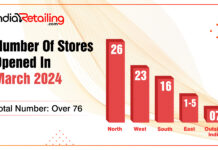The Indian food service sector has seen exceptional growth during the past decade and continues to expand at a fast pace. This can be attributed to a high percentage of young and working population with rising disposable incomes. Availability of organised retail space has also helped the industry to encourage the growth of local and international brands across different formats.
According to FICCI-PWC report ‘The Changing Landscape Of The Retail Food Service Industry’ following are the trends that will shape the Indian food service industry.
1. Trend#1: Ethnic cuisine will increasingly be present in organised and hygienic set-ups
In the fine or casual dining space as well, regional cuisine restaurants are slated to come up. It is expected food from states such as Kerala, Tamil Nadu and Kashmir will flood the Indian restaurant market. More and more restaurants will come up focusing on cuisines from the North East, Odisha, Chhattisgarh and Himachal Pradesh.
Over the last few years, as food delivery apps, quick-service restaurants (QSRs) and take-away outlets have begun to dominate, biryani has emerged as an unlikely champion of India’s fast food scene, unseating pizzas and burgers, which used to dominate standardised fast food kitchens. According to food delivery apps, it is among the most popular dish ordered and its demand far surpasses that of Western imports.
The rise of ethnic cuisine has not been limited to QSRs or dine-in restaurants. It is also evident in the cafe space with the rise of a multitude of chai cafes. Tea chains around the country are looking to break free from their traditional outlook and that of their older and more established counterparts-coffee retail chains. By focusing on the tea drinking experience, labelling tea as a wellness brew and creating novelty around a familiar product, tea cafes are wooing students and young office goers. This makes sense as India has traditionally been a tea-drinking nation. For every cup of coffee, an Indian drinks around 30 cups of tea.
2. Trend #2: Food tech will continue to ‘organise the unorganised’, driving increased focus on consumers, food innovation and efficiency
The entry of food tech start-ups has led to a massive transformation of the operations of the Indian food industry. Growing disposable income and busy lifestyle of the young and working population, coupled with increasing internet penetration and rising smartphone users, will continue to drive India’s food tech market trough 2021.
In 2015, the food-tech sector in India went through a period of turmoil when several start-ups had to shut down. This was followed by a period of consolidation and correction. The situation turned for the better in 2017 as food-tech companies fine-tuned their business models and improved their unit economics. This consolidation wave in the food-tech space saw as many as 24 mergers and acquisitions between 2015 and 2016. In 2017, two predominant models-restaurant marketplaces and cloud kitchens-evolved following the upheaval. The recovery was led by a reduction in delivery costs and increased penetration in existing markets.
Keeping the focus on consumers, smart curation and personalisation will rule the roost over the next 18 months. The success of a food delivery platform is a function of convenience, reliability and selection. However, as more and more restaurants come onto food delivery platforms, balancing choice with ease of using the app and placing an order can be a challenge.
While most food delivery platforms have carousels with collections of restaurants, in the coming years, customising this function will help in reducing the overall time taken by consumers to make a choice and place an order. Just like when you open up Netflix and get recommendations on movies, getting food recommendations based on past orders and preferences will increase ease of use.
Some of the food tech start-ups are also working with restaurants to improve and expand kitchens.
3. Trend #3: Restaurants will increasingly focus on consumer engagement using technology
Nowadays, technology has become a basic prerequisite to ensure that operations are carried on seamlessly, and the restaurant industry is no different. This sector too has impacted by the wave of technological innovations, which have taken restaurant operations to a new height. This overwhelming presence of technology will not decline; on the contrary, we will continue to see new equipment, improved methods to spread awareness and increaseing the use of restaurant technology. Some of the key technological interventions expected from restaurants in the immediate future are:
– Point of sale (PoS) Systems
– Automated Marketing
– Social Media
– Use of tablets
– Bill split option at table
4. Trend #4: Social media will continue to transform relationship with consumers
Social media has become a powerful asset for marketing within the food services industry. As sharing food through social media becomes increasingly important, particularly for millennials, stand-out food concepts are thriving. Food is becoming clickbait of sorts for restaurants and ‘instagrammable’ food is becoming increasinlgy vital to millennials.
Since its inception in 2010, Instagram has been the prime platform for sharing photos of food. Nonetheless, the dynamic between food and social media has changed. Instagrammers have moved away from sharing lunchtime photos as a competitive sport to purposefully documenting the must-eat meals of the moment. The app is still heavily populated with attractive meals, but they’re now aimed at influencing, even transforming, how we cook and eat. In version 2.0 of social media’s relationship with food, the world has shrunk and a new demographic of home cooks, food bloggers, farmers and other culinary aspirants has emerged, spawning trends and changing things, one aesthetically staged photo at a time.
5. Trend #5: Health and wellness will continue to ride high on consumer preferences
Overall, the health and wellness food service industry will continue to grow as consumers become more conscious about their diet by trying to eat healthy, going for farm-to-table lunches, growing their own garden herbs, buying as much organic produce as they can afford, trying new millets and consciously avoiding junk as much as possible.
– Neuro nutrition will lead the way
– Consumers will go back to flavour roots
Still, the landscape could see a lot more packaged food companies in future, especially due to the e-commerce channel. Health food is still largely an urban, metro phenomenon. Awareness has not yet trickled down to other cities. Premium pricing of such products and a nascent supply chain also put most products out of reach for consumers in non-metro areas. However, with growing consumer preference, it is only a matter of time before the health and wellness food service industry expands it base and becomes a prominent part of the overall food service industry.
6. Trend #6: Traditional packaging will make way for innovative food packaging
With millennial spending still ramping up, food manufacturers and retailers have already begun to reshape their marketing strategies in order to cater to millennials.
Millennials are estimated to be around less loyal to brands than previous generations; thus, in order to target them effectively, brands need to focus on their global, digital, and social presence rather than their on shelf presence. This essentially means that a product needs to trend globally (as millennials are globally connected) and be digitally accessible and unique (as millennials increasingly shop online) and ‘socially sexy’ (have an ‘Instagram Appeal’ that offers the purchaser social status). Due to an increasing importance of these factors and the fact that prices across brands and retailers are mostly at par, creating a unique brand that targets core beliefs and behaviour of millennials is vital. To achieve this, retailers first need to understand the millennials’ core beliefs and then design a brand around them.
What do we already know about the ways in which millennials eat and purchase food? How could these characteristics change things like packaging?
– Take away concept – The busy millennial lifestyle calls for more meals on the road. An Alphawise study of millennial eating habits found that Gen Y frequents restaurants more often than other generations. However, claims about healthy dining habits are not always true. Whether it is a casual lunch at a vegan ramen house or bacon double cheeseburgers from the nearest fast food joint, millennials eat out more at all venues across the board.
Food manufactures and retailers e.g., supermarkets with in-store menus could offer competitive services, so long as they offer mobile packaging option that allow millennials to eat wherever their hearts and short attention spans take them.
– Cementing the social experience – Millennials usually have multiple social media accounts. Gen Y-ers are not only on sites such as Facebook, Twitter and Instagram, but they have certainly perfected the art of balancing multiple online personalities. Mobile technology such as smartphones and tablets gives them an even enhanced edge in this regard. As such, food companies should constantly be considering new ways to incorporate customer interaction by way of mobility and social media.
Merchandisers lacking mellennial-level creativity do not necessarily have to reinvent the wheel. For example, if a company’s traditional packaging includes redeemable coupons, they may consider replacing the printed coupons for a QR code accessible via the web. Businesses can save money on printing costs and engage younger audiences by encouraging them to participate electronically. Furthermore, image-driven content created through apps such as Instagram, Pinterest and Vine gives food companies an opportunity to showcase their product’s unique sales proposition with free viral marketing. Never underestimate the power of the hashtag!!
– Environmentally conscious buyer – Environment-friendly, sustainable, recyclable, and compostable packaging is no longer a trendy option. Light-weighting and mineral filler usage is gaining interest, which can help both the environmental and economic goals of companies and consumers alike.
Commercial packaging, therefore, has to step up its game and convince Gen Y that contents are honest and worth buying. This could include printing clearer nutritional and ingredient information right on the box or even directing prospective buyers to online resources such as videos and testimonials that back up marketing claims.








